
Durum-Kamut Italian Bread
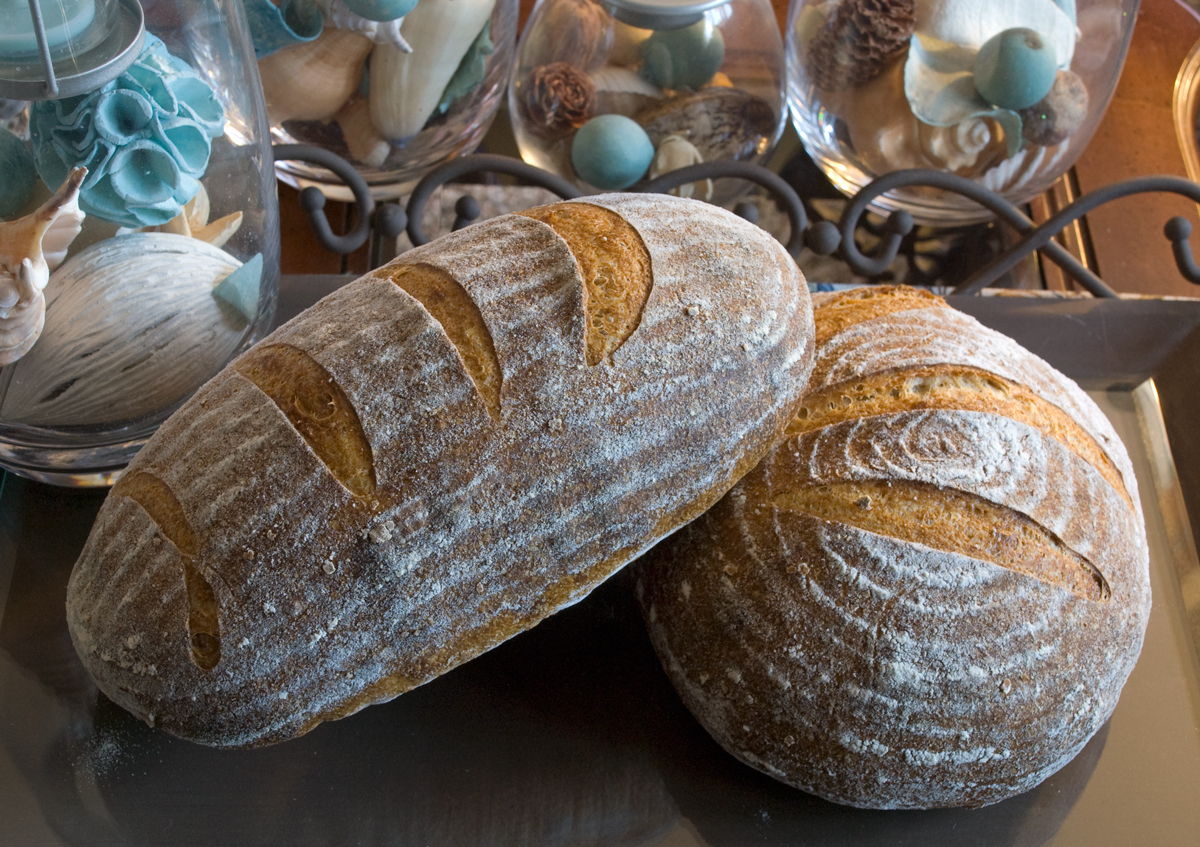 Earlier in the week I attempted to make a bread using a raspberry dessert wine and I didn't take my own advice and used too much wine in the bake. It did not develop properly and the final bread ended up gummy and is now food for my compost pile.
Earlier in the week I attempted to make a bread using a raspberry dessert wine and I didn't take my own advice and used too much wine in the bake. It did not develop properly and the final bread ended up gummy and is now food for my compost pile.
For my next bake I wanted a more simple bread and after watching an episode of Lidia Bastianich's TV show on Italian cooking I had a craving for a nice hearty Italian Durum Semolina type bread that you can dip in sauce or olive oil.
I recently made bread with Kamut which has a similar color and nutty flavor like Durum wheat and I wanted to combine the two together along with some organic Bread Flour I just received from KAF to add enough gluten to pull it all together. Kamut wheat does not have a strong gluten structure so it's important to combine it with a flour that has a higher protein level.
I have to say that this dough came together as a nice silky moist and tacky dough and was easy to work with. The final bread had a wonderful yellow crumb which was nice and open. The crust was just chewy enough as to be ideal and made this a joy to eat dipped in some olive oil with a little roasted red pepper.
If you make this bread I guarantee you will have a hard time stopping yourself from finishing the entire loaf in one sitting!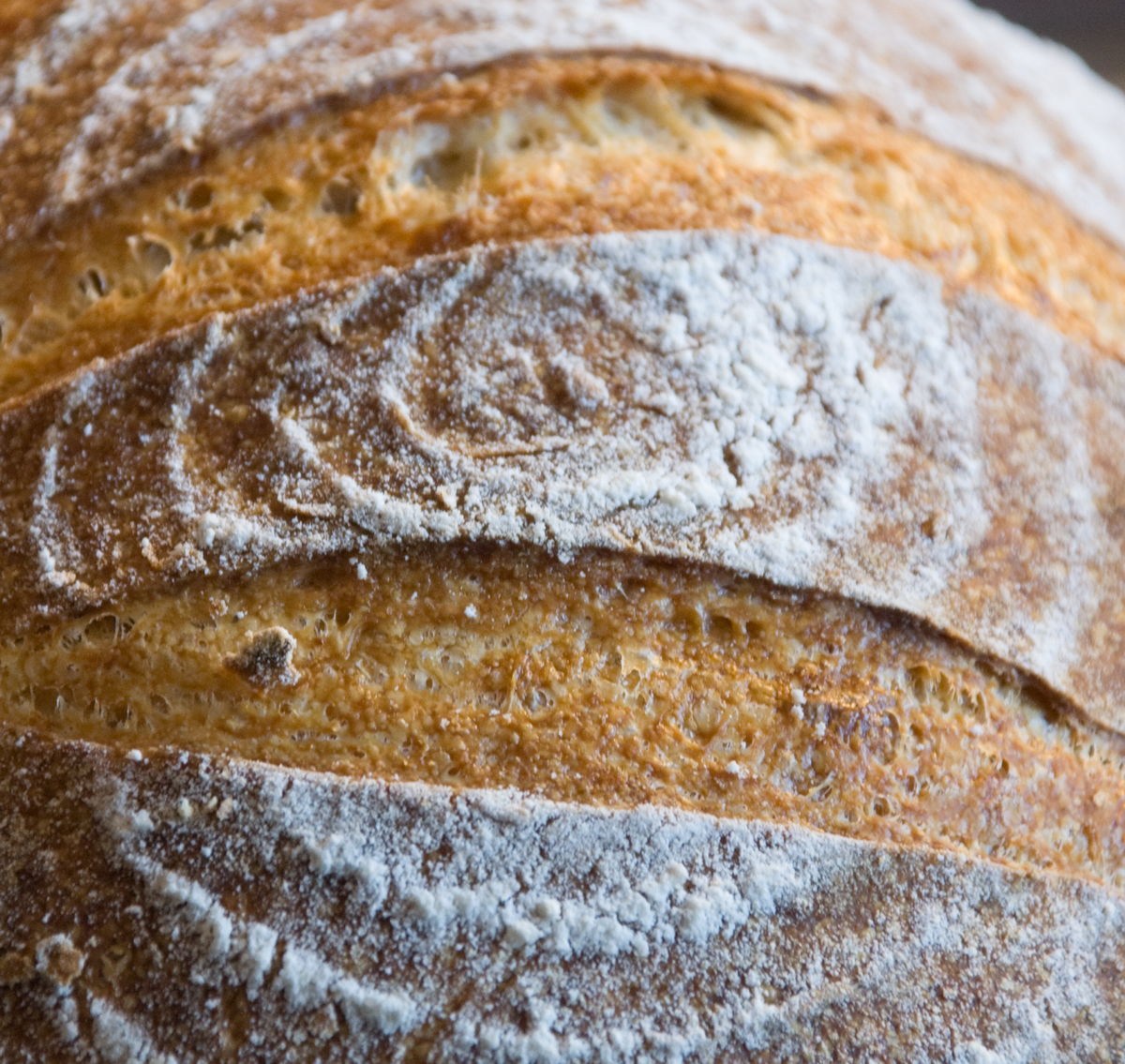
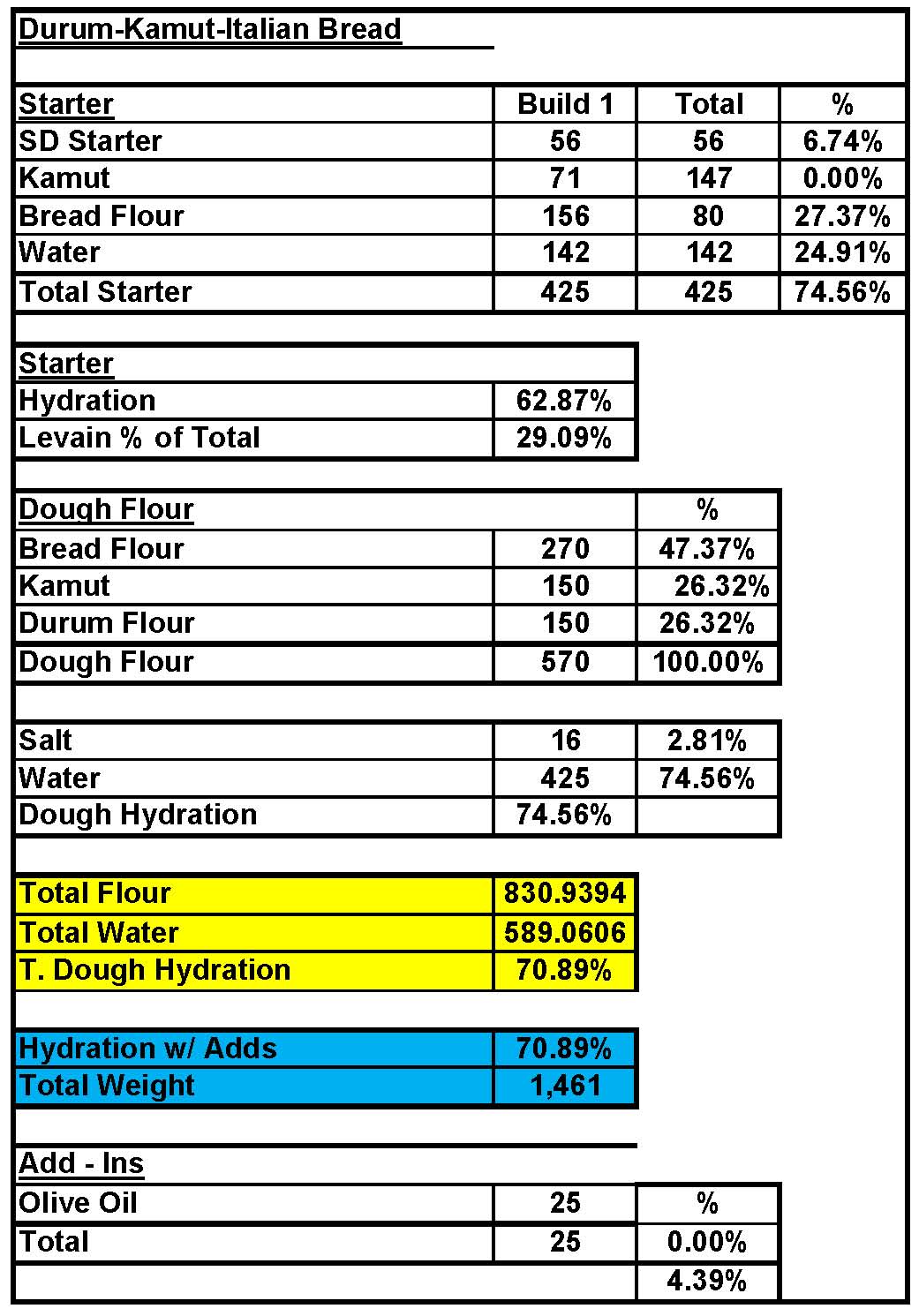
Levain Directions
Mix all the levain ingredients together for about 1 minute and cover with plastic wrap. Let it sit at room temperature for around 7-8 hours or until the starter has doubled. I usually do this the night before.
Either use in the main dough immediately or refrigerate for up to 1 day before using.
Main Dough Procedure
Mix the flours, and 375 grams of the water together in your mixer or by hand until it just starts to come together, maybe about 1 minute. Let it rest in your work bowl covered for 20-30 minutes. Next add the salt, starter (cut into about 7-8 pieces), and olive oil and mix on low for a minute. Add the rest of the water unless the dough is way too wet. Mix on low-speed for another 4 minutes. Remove the dough from your bowl and place it in a lightly oiled bowl or work surface and do several stretch and folds. Let it rest covered for 10-15 minutes and then do another stretch and fold. Let it rest another 10-15 minutes and do one additional stretch and fold. After a total of 2 hours place your covered bowl in the refrigerator and let it rest for 12 to 24 hours.
When you are ready to bake remove the bowl from the refrigerator and let it set out at room temperature still covered for 1.5 to 2 hours. Remove the dough and shape as desired. I made 2 loaves using my bannetons. Place your dough into your proofing basket(s) and cover with a moist tea towel or plastic wrap sprayed with cooking spray.
The dough will take 1.5 to 2 hours depending on your room temperature. Let the dough dictate when it is read to bake not the clock.
Around 45 minutes before ready to bake, pre-heat your oven to 500 degrees F. and prepare it for steam. I have a heavy-duty baking pan on the bottom rack of my oven with 1 baking stone on above the pan and one on the top shelf. I pour 1 cup of boiling water in the pan right after I place the dough in the oven.
Right before you are ready to put them in the oven, score as desired and then add 1 cup of boiling water to your steam pan or follow your own steam procedure.
After 1 minute lower the temperature to 450 degrees. Bake for 35-50 minutes until the crust is nice and brown and the internal temperature of the bread is 205 degrees.
Take the bread out of the oven when done and let it cool on a bakers rack before for at least 2 hours before eating.
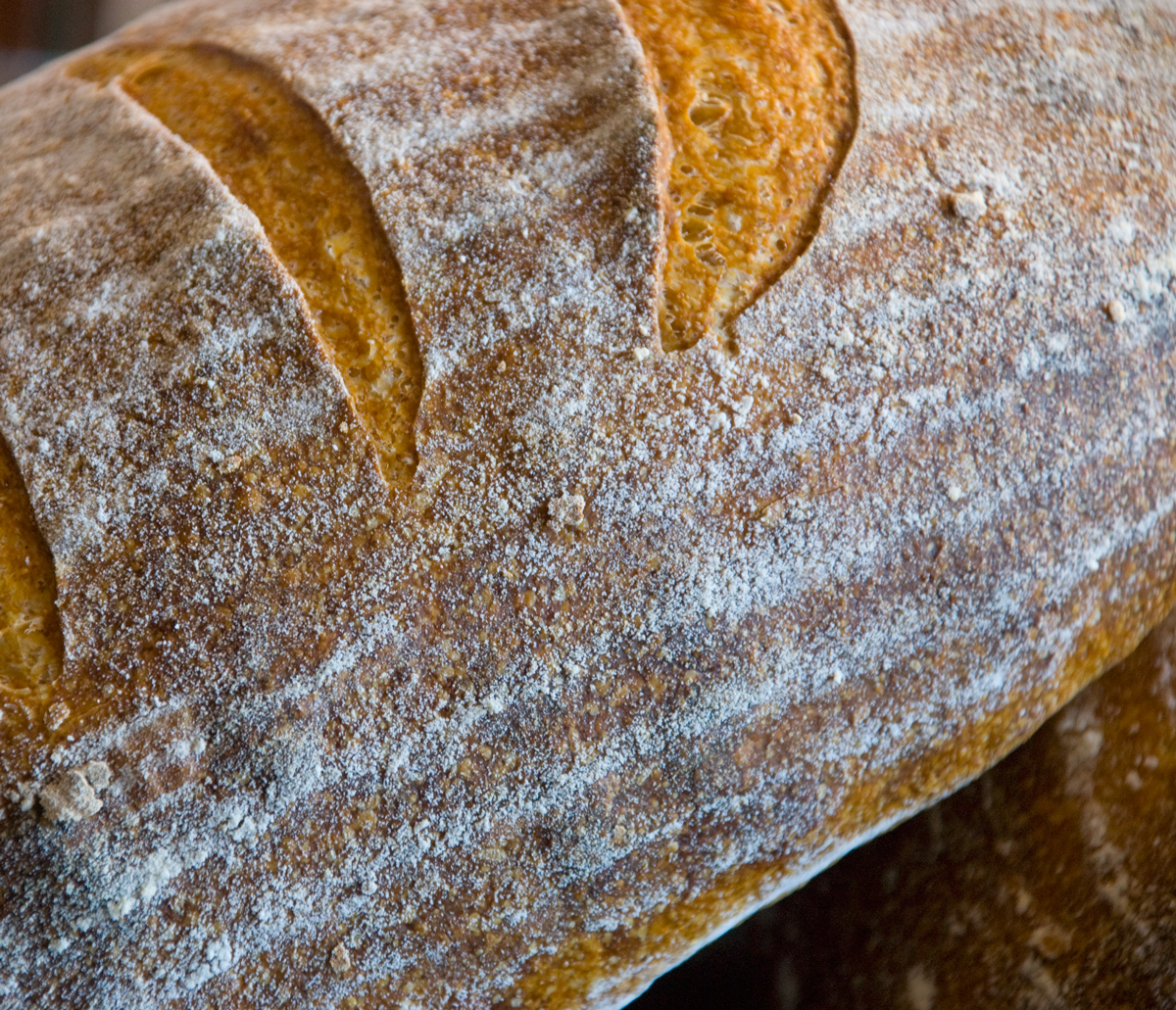
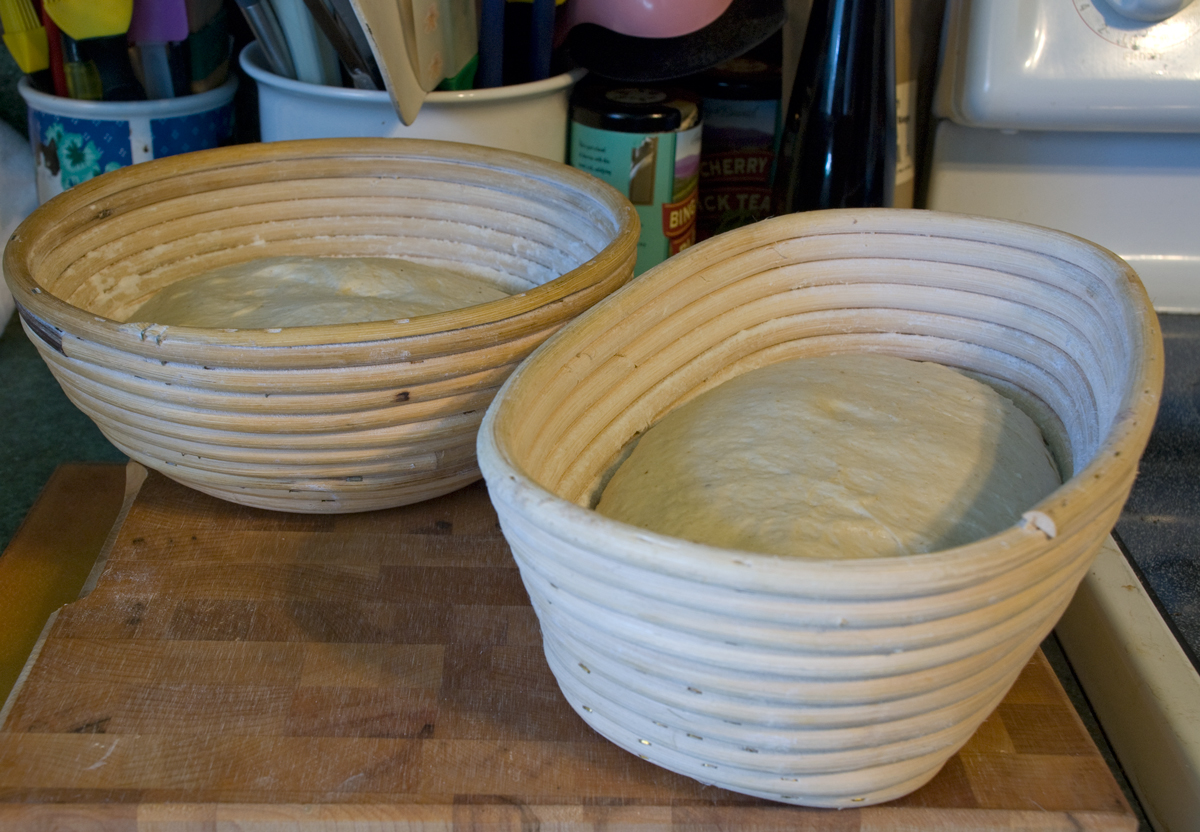
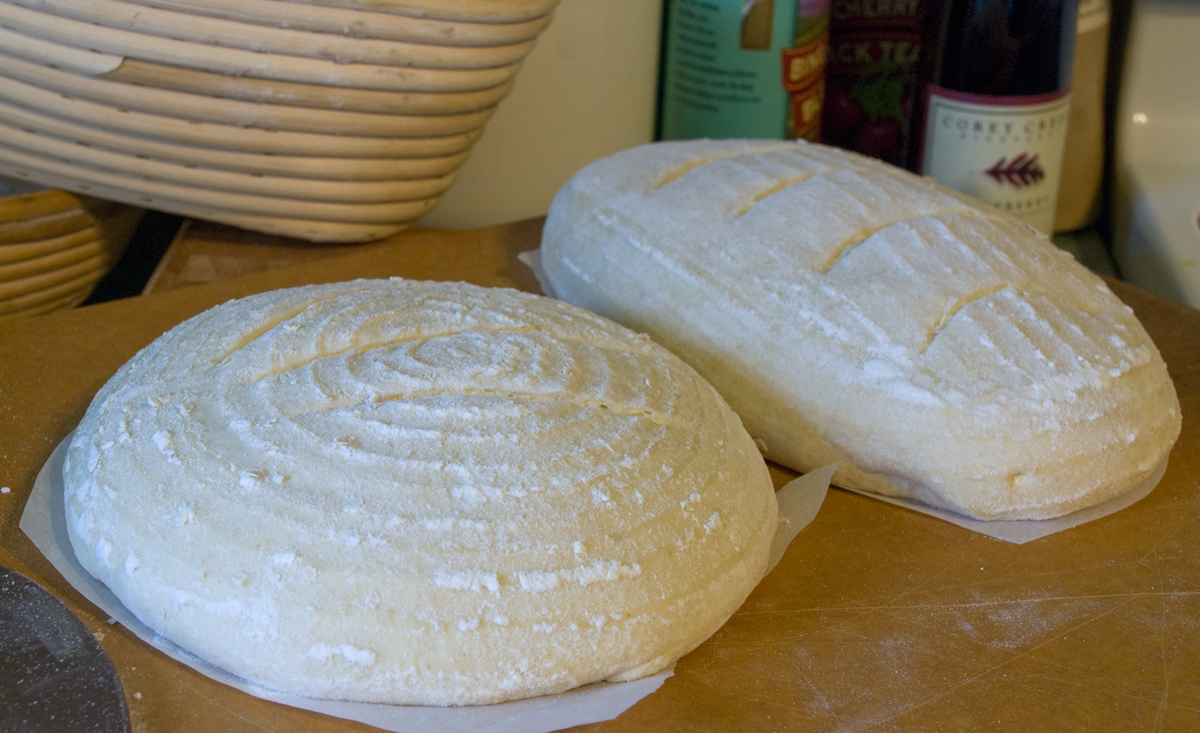




Comments
Yum, Ian! Beautiful loaves, and an excellent dip choice!
How did you calculate the wholegrain %? Can't be 80% with all the breadflour.
Your shaping skills and dough handling have improved exponentially!
wow.. beautiful loaves. nice shiny crumb. love the color of the crust, almost like gold. tempting.. simple yet divine. definately gonna try this one soon.
evon
Thank you Evon.
I don't think you will be dissapointed. This one came out as good as I could have hoped and is certainly one worth making again.
Look forward to your next post.
Regards,
Ian
Thank you so much Khalid.
I am using a spread sheet that our friend DA sent me and I must have neglected to change something. You are right of course there are not really any whole grains in this one.
Thanks for pointing that out....actually I put that in there to see if anyone was actually reading it :).
I will have to fix that shortly.
This dough came together nicely and I am very happy with the flavor and especially how the crust and crumb came out.
Regards,
Ian
That one's a total winner. Sends memory of overly winey loaf to compost I'm sure. Flavor must be sublime here. And crumb with so much gluten challenged flour -- hats off.
I'll be surprised not to see this one displayed up top. Pix are terrific. Floyd, you reading?
Nice one Ian.
Tom
Thanks so much for the kind words Tom....I'm blushing like my red wine I wasted! My wife scolded me for using a dessert wine that she claims cost $30. I think her memory may be off a bit, but in any case I was very happy with the way this one came out and if you get a chance I hope you give it a try yourself.
Regards,
Ian
indeed! but you don't need to add bread flour and reduce the taste to obtain a crumb like that. Stretch and fold won't work, though.
OK Nico, now I have to ask. If using bread flour (to contribute gluten) and folding (to organize it) is not the way to get a nice crumb like that from a formula comprised of flours like those, then what are you recommending? I'm anxious to learn of your approach, as I trust your judgement on cose durum.
Thanks.
Tom
I think what he means is if you want you can use 100% durum but you need to do intensive mixing and kneading to achieve a good gluten structure.
I follow txfarmer's teaching: knead knead knead until you get PERFECT gluten development. There are flours that develop well with stretch and fold, too, but durum and kamut (another durum) are not among the few lucky ones. I tried dozen times and I had 100% tearing rate.
I hear you! Tha's why I added the bread flour since I prefer to use the stretch and fold method rather than kneading for so long but one of these days I will try the 100% formula and give it a go.
Thanks for your comments.
Ian
Nico,
Interesting discussion. One I have missed reading about when using Kamut or Durum. Can you tell me other flours that don't do well with S&F?
I generally mix flour, water and leaven and let it rest for 60 min. then I add the final ingredients and knead using my DLX until I get moderate gluten devel. I let the dough sit out on the counter for several hours before refrig. overnight and do a couple of S&F during that time to develop the gluten to its final stage. I do this with my enriched doughs as well as with my lean doughs. I have had issues with tearing in the past with some loaves but hadn't attributed it to the flour being used....so now I get to learn something new :-)
Now I am curious because I always though all flours, except rye, could be kneaded in a machine or worked with S&Fs.
Janet
Ian - hope I am not hijacking your thread....I am just curious...
Hi Janet, everything that tends to have a weak gluten, such as spelt, wholemeal flour (there are several strong wholemeal flours, but they are exceptions rather than the norm) and even mixed rye doughs tear miserably when the fermentation begins to swell considerably the dough.
Right yesterday I baked a 33% wholemeal rye (even starting with my rye starter that generally liquifies my doughs) with 66% strong-ish flour (not as strong as real bread flour). I kneaded until the gluten developed moderately perfect:-). The bread came out fantastic, exceptionally light and airy and with a crackly crust. In other occasions the same dough (or even doughs with a lesser percentage of rye) teared during proofing and flattened during baking because I didn't develop gluten well enough. By airy and light I mean that loaf that seems to be weightless when you take it in your hands.
Gluten needs energy to develop but without kneading you don't provide any energy. Even oxydants such as vitamin C work very differently depending on how much you knead (I have it, I test its effects all the time). It's really night-and-day, I can't express it any better.
If I can say it there's not a single recipe as DISeducational as no-knead bread. In the past people used to knead a lot, meaning A LOT, then suddenly someone came out with this no-knead approach and ... a lot of focaccias -rather than bread- began to appear. No knead works well with strong flours, but this detail isn't explained anywhere. People try this no-knead stuff with the wrong flours (weak, I know perfectlty well how weak flours behave) and ... should I continue? :-). I have seen literally thousand of wannabe-breads made with that method using italian flours, and I can assure you that it's not a nice view.
Sorry for this hijacking Ian. If you prefer I'll move this discussion to a different thread.
Nico
No problem Nico.
I agree with your assesment on the no Knead doughs which don't even do Stretch and folds. Most of my baking involves mixing for about 1-2 minutes with my Bosche and then mixing/kneading for another 4-5 minutes. I then do 3-5 stretch and folds or more if the gluten is really slack and in the deep dark cold to sleep for 12-24 hours. I find this works great for most of my formulas but I tend to mix in at least 1 stronger flour in my mixes to compensate for the issues you have outlined above.
Thanks for sharing your experiences and expertise on this matter.
Ian
Hi Nico,
Thanks for putting this into words. There are so many recipes that state to use S&F but do not educate one as to why and when it isn't an appropriate method to use. You words have confirmed what I have experienced in my kitchen but I hadn't been able to pin point with words what I was seeing. Now, thanks to you, I know!
The flour I always use is freshly ground flour that I grind so it isn't as strong as bread flour. I have read about the weaker European flours - especially the Italian ones, in posts here so I am guessing what I use is probably stronger than what you can get but is still weaker than what people here buy in the grocery store.
I know I did learn about intensive kneading when baking txfarmers 100% whole wheat shreddably soft sandwich loaves so that is the method I employ when making a lot of my enriched doughs. I have sort of fallen into that way of kneading except when I make a lean loaf with all ww flour. Those doughs do seem to develop their gluten structure much more easily and I can get away with using a bit of machine kneading followed by several S&Fs. I know if I add rye to any of my doughs using ww flour - the kneading time does increase but I make sure the kneading is very gentle.
Thanks for taking the time to respond to my question and clarify this mystery for me.
Thank you too IAN for allowing me to make these comments in your post!
Take Care,
Janet
Janet, one last thing to consider is that eggs (especially yolks, but also whites) have a HUGE strengthening effect on the dough, that's why your enriched dough develop more and rise more.
Glad to be helpful!
Nico
That's an interesting point. What if you put eggs in your 100% durum bread? Do you think that would counteract the need for such intensive kneading? May be an interesting experiment to try.
Ian: the strengthening effect is still due to proteins. I guess that without energy these added proteins woldn't do any magic. Proteins have a potential, but in order to use it you have to give them structure.
I guess that makes sense. This is why I love baking bread...so many options and techniques to try. It's amazing how some tried and true methods and certain techniques which you are never supposed to follow end up being un-true. It's fun to push the boundaries and not listen to what the experts always say sometimes because every once in a while you may stumble upon something new and exciting.
Hi Nico,
So many 'fine' points to remember....I have read that eggs add strength but hadn't thought of using them when using a weaker flour to see how they impact the dough. The only time I use eggs is in doughs that already have other enrichments so it is hard to know which ingredient is having what effect.
You have given me a new thing to experiment with so I can see for myself just exactly how an egg will impact the structure of a dough all by itself.
Thanks for the tid-bit :-)
Take Care,
Janet
The rise and spring of this loaf is impressive. Can't help but love the color durum and Kamut put in the crumb and in the crust, nothing like it really. Both, unless you can find some Desert Durum, don't as have much gluten as bread makers would like, so the delicate touch and super high gluten bread flour for KA compensated beautifully. I'm assuming you are using whole Kamut berries since I can't, and don't want to find Kamut flour.
A combination of Kamut, spelt, rye and ww in eual is the standard mix for our favorite tasting bread by a far and away measure - if at least 50% of the mix with most of it in the levain.
Don't forget that Kamut and spelt make for the other great tasting and healthy foods too. Polenta, pilaf and in soups, gruels and stews. Even though some don't like it because Kamut is so chewy, it is super in my book for sprouts, scalds and soakers too - but you have to like the chew. Plus Kamut just tastes and smells better than spelt in my book.
Your bread would hard to top with those mix of flours Ian - really nice.
Happy Baking
Thanks as always DA for your comments. I actually did use Kamut flour that I ordered through Breadtopia.com. I bought some berries as well but have not tried them as of yet. I really like the way the durum and the Kamut complimented each other and made for a great tasting bread.
What do you have up your sleeve next??
It is the end of the orange and minneola season. The trees will be blooming next week so I have been trying to strip the trees and get them processed into frozen juice, marmalade and arancello before giving the rest to the food bank. My wife is off work for spring break next week so probably no baking allowed.
I did find a bottle of orange skins sitting in grain alcohol dated March 28th - when it was supposed to be strained off and mixed with the simple syrup. So that was last years crop of arancello that went into the bottle the end of January so it is now over a year old. Never really done one past 6-9 months before so that will be a very good bottle.
Doing a pork shoulder today to have BB pulled pork sandwiches on the beet buns for dinner. Yum! I also found a YW levain in the fridge that needs to get used up though and I need bagels - so maybe bagels in a couple of days.
Hopefully I've seen the last of the snow for this season so I can get back on the BBQ myself. I can smell your pulled pork all the way on Long Island! I've got bagels on my to bake list too. Enjoy your wife's Spring Break and look forward to your next creation. I'm seeing some kind of bread oranges and minneola :)
Ian,
Beautiful loaves and scoring! You % of Kamut is close to what I have come up with (I use 25% just cuz it is an easy % to deal with) : when I use it in free standing loaves. Not sure how I arrived at that figure but somewhere along the lines it must have done something I liked and I have repeated it ever since. *-)
I have never used durum flour so I don't know of its flavor or how it adds to dough strength but obviously it was a great choice of flour for this loaf.
Thanks for sharing this loaf!
Take Care,
Janet
Thank you Janet as always for your comments. If you can get some Durum flour do try this one as I'm sure your lucky recipients would be happy.
Regards
Ian
They are picture perfect, crust and crumb. You obviously got lots of dough strength the way they are standing up after removing from the brotforms, maybe since you are using a firm starter here. I've read that a firm starter enhances dough strength while a liquid starter improves extensibility. Do you think the firm starter made up for some of the weaker flours that you used? Have you ever tried this recipe with a liquid starter?
-Brad
Thanks Brad for your comments.
I prefer to use a firm starter in most of my baking but sometimes I do convert over to a 100% hydration one. I don't really think this has much to do with the overal gluten strength. It really has more to do with the overall hydration of the dough as well as the types of flour used and method used to develop the gluten. I like to use my mixer for only minimal gluten development and then use stretch and folds as well as an overnight rest in the fridge to further develop the gluten without a lot of kneading.
There is tons of info on this site about the benefits or attributes of using a firm starter versus a liquid starter. I've read so much about it myself that I'm having trouble keeping it straight!
I believe a firm starter is supposed to lead towards a more sour dough but I could be mixing it up at this point.
Thanks again for your kind words.
Ian
Lovely scoring (I say that a lot when it comes to your loaves.) I love the nice soft buttery crumb. -Varda
Thank you Varda.
Appreciate it.
Regards,
Ian
Have a question about the spreadsheet numbers. What are the numbers in the 2 columns under levain ? There is 1st build and then total...not sure what this means :( Evidently having a brain gap !
I am in VA taking care of grandbaby but will get back to baking next month. Loaded up all that I baked last week and brought it with us so the freezer is full. I look forward to your next invention. c
Thanks for your comments.
I've been using a spread sheet I got from DA and I'm still getting the hang of it. Looks like I have to go and see where I went wrong.
thanks again.
Ian
The bread screams tasty. Love the crumb. I have been unsuccessfully trying to find durum flour, Kamut is a long way off. Would have liked try my hand at this one.
Thanks Alpana.
Appreciate your kind words.
I hope you get a chance one day to try durum flour as I'm sure you will love it.
Regards,
Ian
I tried a Kamut bread a couple weeks ago and it was OK - however I often do the durum wheat flour bread (DMSnyder originally) - soI love the idea of trying both!
OK that's got this week sorted
and thanks everyone for the discussion on kneading and strength etc - I must admit I've got lazy with mix then S&F for most "normal" (not enriched) doughs, so I should probably try other methods!!
thanks again for the idea
cheers
S
PS Have you tried the recent recipe for red wine & cranberry sourdough? I did this last weekend, but unfortunately couldn't taste it as my colleague on the CamBake stall sold it! Will try again - I'm not yet sure about alcohol in bread (well, for many reasons!) and this certainly extended the rising time...
I hope you give this a try. I think you will not be disappointed.
I tried a version of the wine bread but I didn't follow my own advice and used too much wine and the dough did not develop properly.
I've made a successful bread with white wine so I'm sure I will figure out the red one as well. The alcohol mainly gets baked off, but it does tend to slow down the wild yeast activity a bit so you have to be careful with how much you use and someone else suggested it could be from the Tannen's in the wine as well.
Thanks for your comment.
Ian